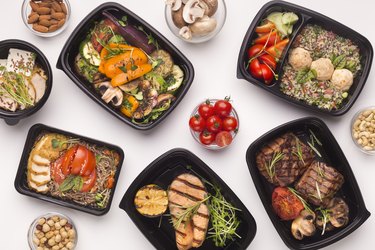
The food we eat provides energy that give our bodies fuel to perform all functions from the most basic like breathing to more complicated activities. We need a minimum amount of calories from food to sustain basic metabolic functions and more to carry out physical activities. The more active we are, the more food we need.
Tip
The process of changing food into a usable form starts with chewing your food, according to University Hospitals. Your body then converts food into energy used by your muscles and various bodily systems.
Video of the Day
How Do We Get Energy From Food?
Your body converts food into energy not only for strenuous physical activity, but also for activities of normal daily living. In the process of changing food into a usable form, the action of chewing begins the digestive process. Enzymes in your digestive system further break down the food molecules, according to University Hospitals.
Video of the Day
This food-to-energy process converts sugar and fat into a molecule called adenosine triphosphate (ATP), according to the LibreText Libraries. ATP is then transformed into a similar molecule called adenosine diphosphate (ADP). As this change occurs, energy is released that your cells use to fuel bodily functions — like breathing, holding a cup of coffee or completing your daily workout.
You'll need to strike a careful balance between input and output for this food-to-energy process. If you take in more food than your body uses through daily living and exercise, then your body will store the excess energy — aka calories — as fat.
When you take in only the calories you need, your body will maintain its weight. Take in fewer calories or use them up through exercise, and you create a caloric deficit. Over time, this deficit can allow for weight loss as your body uses stored fat for energy.
Focus on a Healthy Diet
Eating a balanced diet within your recommended calorie range will help you properly manage the input and output of calories. Depending on your sex at birth and your activity levels, adults need anywhere between 1,600 to 3,000 calories per day, according to the USDA 2020-2025 Dietary Guidelines for Americans.
In addition, aim to eat a balance of macronutrients — about 45 to 65 percent carbohydrates, 25 to 35 percent fat and 10 to 30 percent protein, per the USDA. Carbs and fats are good sources of energy, according to the LibreText Libraries. Proteins, vitamins and minerals are mainly used as building blocks for various processes — like building muscles, for example.
Focus on a healthy eating pattern with a variety of fruits and vegetables, whole grains, low-fat or nonfat dairy, lean proteins, some healthy fats and minimal added sugars and sodium, recommends the Harvard T.H. Chan School of Public Health.
This type of eating pattern will help you feel full and stave off illness and disease. Dietary fiber, found in plants and whole-grain foods, helps to promote satiety and reduce the risk of chronic conditions like diabetes and heart disease, according to November 2014 research in Advances in Nutrition.
How Muscles Use Energy
In general, muscle fibers are classified as either slow-twitch or fast-twitch based on how they use energy for fuel. Aerobic exercise like distance running produces more slow-twitch fibers for greater endurance, according to the International Sports Sciences Association (ISSA).
Anaerobic exercise like sprinting or powerlifting increases the size and quantity of powerful fast-twitch fibers. These fibers fatigue more rapidly and are used for quick bursts of energy. Training these muscle fibers also improves the strength of muscles and allows them to grow in size.
Aerobic workouts trigger metabolic changes in the muscle tissue, including an increase in mitochondria — that is, the organelles that use oxygen to help create ATP, according to the American Council on Exercise (ACE).
Along with this increase in mitochondria, there's an increase in the levels of enzymes used to metabolize fat. Your muscles are then better able to access fat and use it for energy, leading to fat loss.
Fast-Twitch for Quick Energy
Meanwhile, fast-twitch fibers use ATP stored in the muscles to generate energy. The metabolic changes produced by anaerobic exercise help to increase levels of ATP and supply energy to muscles, according to the ISSA.
Tip
Because fast-twitch fibers deplete more quickly, they require longer periods of rest between exercises to replace spent ATP, per the ACE.
Your anaerobic workouts fuel fat loss, too. Anaerobic exercise boosts the production of human growth hormone and testosterone, which are both needed to increase muscle size. By growing muscle size, anaerobic exercise helps your body burn more calories at rest. Both types of workouts have a favorable effect on fat metabolism and heart health, according to February 2017 research in the World Journal of Cardiology.
The food-to-energy process allows you to recruit slow- or fast-twitch muscles, depending on the type of exercise. It also gives you the fuel you need to feel alert and go about your daily life
The Bottom Line
All foods supply calories for energy, but not all calories are equal. Foods that give you energy provide more vitamins and minerals for the amount of calories they supply, so choose nutrient-dense options to fuel your daily needs.
Simple carbs like table sugar are broken down quickly and are a fast source of energy, but eating them in excess will lead to fat storage. For a more steady release of energy, choose complex carbs, which are found in whole grains such as wheat pasta and brown rice. Choose lean sources of protein like chicken breast or beans and heart-healthy fats such as avocados and nuts.
- University Hospitals: The Digestive Process: Digestion Begins in the Mouth
- Biology LibreText Libraries: Food Energy and ATP
- USDA: 2020-2025 Dietary Guidelines for Americans
- Harvard T.H. Chan School of Public Health: Healthy Eating Plate
- Advances in Nutrition: Carbohydrates
- World Journal of Cardiology: Aerobic vs anaerobic exercise training effects on the cardiovascular system